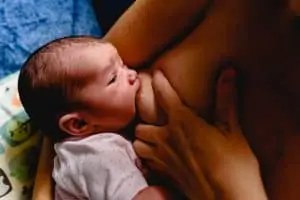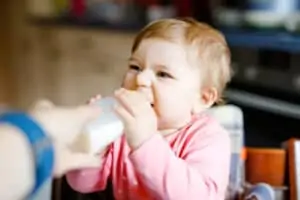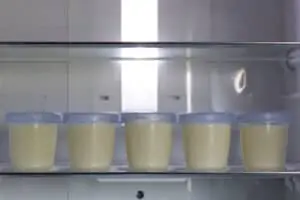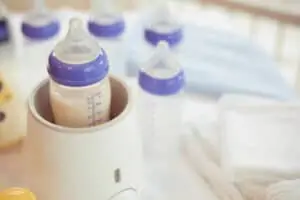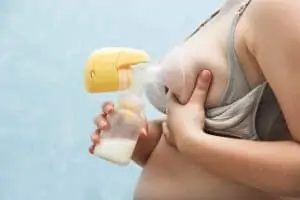Babies are messy, and every parent knows that stains on baby clothes are a big issue. If you don’t learn how to get breast milk stains out of clothes, you’ll end up with a pile of stained, ruined clothes that your baby can’t wear when you go out somewhere.
Formula causes worse stains than breast milk, but both are troublesome to remove. The baby formula tends to stain worse because of all the ingredients, but both cause stains that get darker over time. That’s why you need to learn how to remove breast milk stains, especially if you want to store baby clothes for future kids. Otherwise, you’ll have to buy a new wardrobe for each baby!
If you notice that your baby has breast milk stains on their clothing, here are the steps to get rid of those.
Does Breast Milk Stain Clothes?
Yes, breast milk stains clothing and fabric because it contains protein and fats, just like other mammals’ milk. Protein and fats stain fabric, but it’s possible to remove the stains when it’s done correctly.
You’ll soon realize that breast milk leaves yellow stains on everything from clothing to burp clothes. Breast milk stains are similar to blood, feces, and other dairy products that cause protein-based stains. Protein stains quickly and needs to be kept away from heat.
Do Milk Stains Come Out?
If you want to take out dried breast milk stains, the keys are to use cool water and a heavy-duty detergent that contains a protease and lipase enzyme that breaks down fats and protein. Breast milk is easier to remove than formula, but the method is the same regardless.
Supplies You Need to Remove Breast Milk Stains
It’s best not to use bleach on your baby’s clothing because it has serious health concerns when used around children. Bleach contains chemicals that might irritate your baby’s nose, eyes, and skin; it even causes respiratory problems.
Instead, it would help if you had natural or synthetic stain removers. These are necessary for pretreating stains. Here are a few options.
Oxygen-Based Bleach
The most popular and practical choice is oxygen-based bleach. OxiClean is the best-known brand, but there are off-brand choices as well. These work nearly as well as traditional bleach without harmful chemicals.
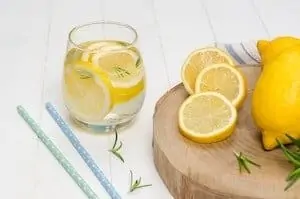
Lemon Juice
100% natural lemon juice is an excellent option for white clothing because it has a natural bleaching action due to the juice’s acetic acid. It’s best only to use this on white clothing because it might bleach colored clothing.
Hydrogen Peroxide
Many people know hydrogen peroxide is a natural bleach alternative that works on tough stains. It’s known for working well on bloodstains, so it will also take out breast milk stains.
Fels Naptha Laundry Bar
You’ll find Fels Naptha Laundry Bars in the laundry detergent aisle. It’s a cheap stain removal bar that works as an easy pretreatment option. It also can be used to make homemade laundry detergent and to clean carpets.
Next, you need a laundry detergent that contains enzymes that will break down the protein. Tide and Persil are two options; Tide Free is safe for babies!
You’ll also want a few scrub brushes and cloths for scrubbing stains.
How to Get Breast Milk Stains Out of Clothes
It’s easiest to clean breast milk stains when fresh; taking care of those as soon as possible is always the best route. However, dealing with stain removal typically isn’t at the top of your to-do list when you have a new baby.
If possible, use stain removal wipes or spray as soon as possible when you notice that your baby has milk on his clothing. If you cannot treat them immediately, put the clothing or fabric in a large bucket filled with cool water and oxygen-based bleach.
Let the clothing stay submerged and soaked until it’s time to do laundry. It’s safe to let them soak for 24 hours or longer. The great thing about using oxygen-based bleach is that it’s safe for both colored and white clothing, so don’t worry. You won’t ruin your clothing.
Never, ever soak or use hot water when treating stains.
When treating a breast milk stain, the protein must be removed first, and hot water cooks the protein. That makes it harder to remove.
After soaking, use your finger or a soft-bristled brush to rub the stain. Then, wash the clothes as you typically would. Most parents use a fragrance and dye-free detergent to prevent skin irritation. What’s most important is that you use a detergent that contains enzymes to remove milk stains.
Don’t Forget to Sun Dry
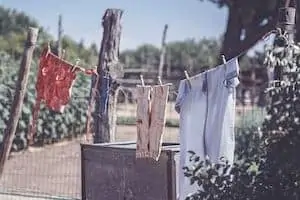
Too many parents forget the power of sun-drying when trying to eliminate stains from clothing. The sun acts as a natural bleacher, so hanging or laying clothes to dry in the sun is a great way to get rid of those.
It’s safe to sun white and colored clothing, but extended time outside might fade colored clothes when done repeatedly.
Always check your clothes before tossing them into the dry. If the blemish remains and you heat it in the dryer, you will set the stain into the fabric.
How Do You Get Old Milk Stains Out of Clothes?
It’s possible that you didn’t notice those at first, so how do you get rid of breast milk stains that are old?
First, scrape or brush off any crusted milk on the fabric. Then, use heavy-duty laundry detergent with enzymes to soak the clothing in cold water for at least 30 minutes. Two good choices are Tide and Persil, which contain plenty of enzymes.
After soaking, use a soft-bristled brush to rub the stains and put them into the washing machine. Use an enzyme laundry detergent to get rid of the stains.
Sometimes, stains are stubborn, and you have to put a bit more effort into getting rid of them. If the above steps don’t work, mix cool water and an oxygen-based bleach, such as OxiClean, based on the package directions. Submerge the items and let them soak for eight hours or longer.
After soaking, check to see if the stains are still present. If they are, make a new solution and repeat. Sometimes, it takes several soakings to remove a persistent spot.
How to Get Breast Milk Out of Carpet and Upholstery
Babies get messes everywhere, so getting spit up on the carpet or upholstery is not surprising.
It’s the easiest to remove the stains when they’re fresh, so take action immediately. Letting the stains soak and dry makes it harder to remove.
First, take a clean cloth or sponge and dip it in cool water. Blot the stained area, moving from the outside area towards the center of the spot. You don’t want to saturate the site; use a paper towel or a clean cloth to remove any extra moisture while cleaning.
Then, mix one tablespoon of liquid dishwashing soap with two cups of warm water. Take a dry sponge to scrub the soap and water on the stain, moving from the outside toward the center. Do this slowly, and the stain will transfer to the cloth or sponge.
After, make sure you take a clean cloth and rinse the area. This might seem like an unnecessary step. But the soap solution attracts soil and might leave a stain. Blot it dry as best as possible and let it air dry naturally.
Breast Milk Stains Don’t Last Forever
Dealing with breast milk stains is frustrating, but they don’t have to last forever. Protein-based ones are hard to remove because they require immediate action and enzymes, but you’ll learn how to quickly get breast milk stains out of clothing with the proper steps.
Hey, this is Linda. My biggest accomplishment in life is being a mother of four children. Their current ages range from almost ten years old down to 20 months old.
I’m passionate about writing parenting articles because I understand so well all of the problems and trials you face as a parent. From breastfeeding woes to budgeting problems and behavior problems, along with everything in between, chances are I’ve faced it over the last ten years. Read more about Linda here.

